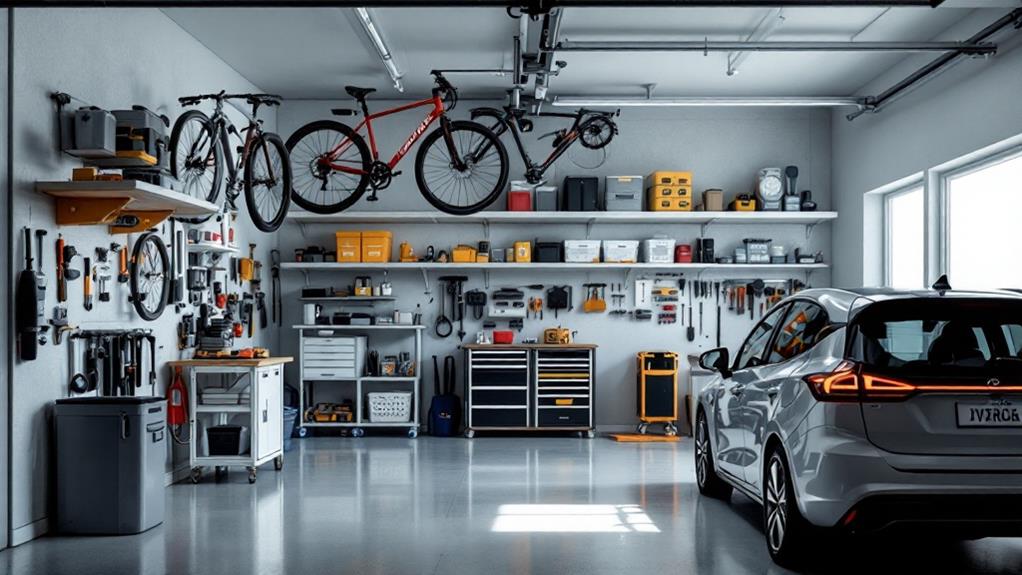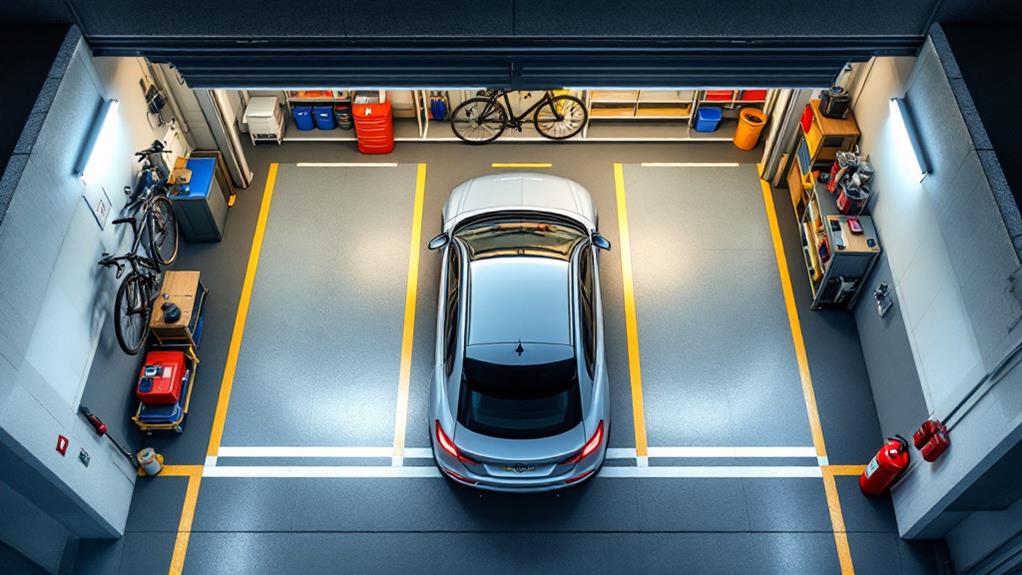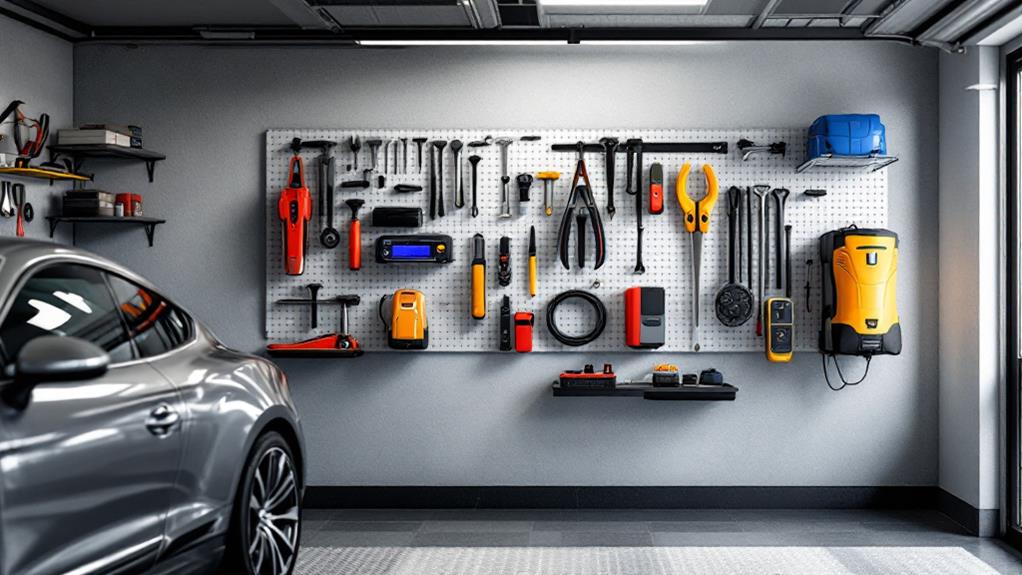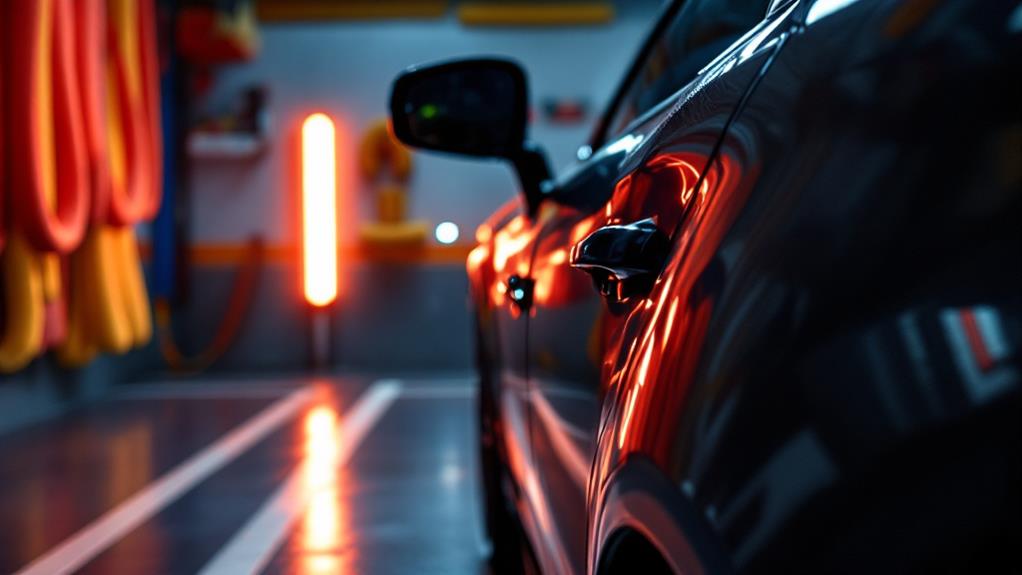How to Park Multiple Cars in a Single Home Garage
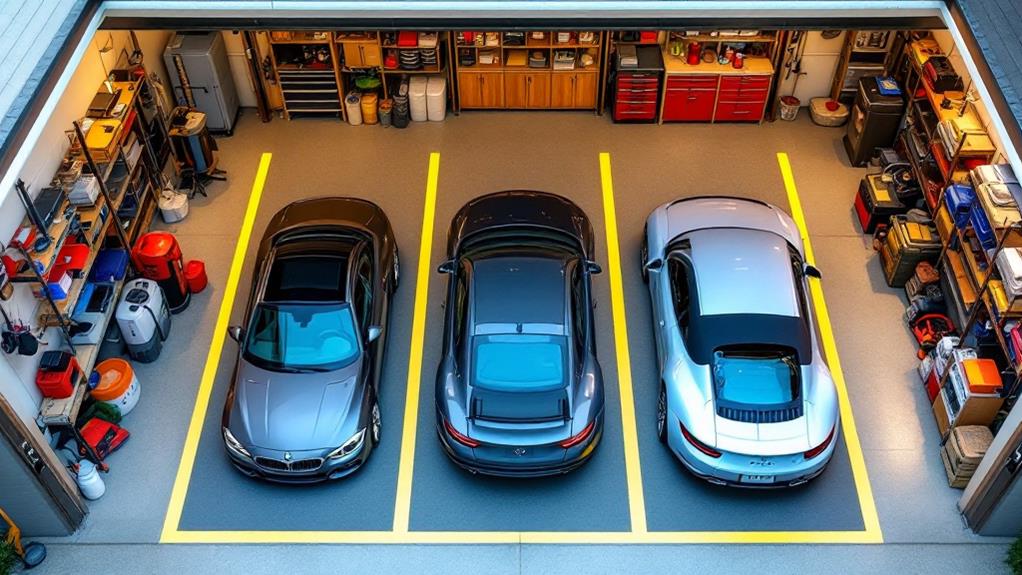
To park multiple cars in a single home garage, start by evaluating your space and optimizing parking positions. Leverage vertical storage solutions to maximize floor space for vehicles. Consider installing car lifts if you need to double your parking capacity. Implement parking aids like hanging tennis balls or floor markers to guide precise positioning. Organize seasonal gear efficiently on walls and in overhead storage. Enhance lighting for better visibility and safety. Don't forget to assess your garage door configuration and plan for future vehicle needs. With careful planning and smart organization, you'll unlock your garage's full potential.
Assess Your Garage Space
Space is the key when it comes to parking multiple cars in your home garage. To determine if you have enough space to fit two cars, start by evaluating your garage's dimensions. Measure the length, width, and height to get a clear representation of your available parking space. Consider whether your garage can accommodate one or two full-size vehicles comfortably, or if it's better suited for one car plus storage.
When assessing your garage space, think about the configuration. Single-door, two-door, or tandem layouts can impact how easily you can maneuver and park two cars. Older garages built for smaller vehicles may present challenges when trying to fit modern, larger cars. If you're struggling with limited space, investigate practical solutions like using wheel dollies or arranging cars in tandem.
Keep in mind that newer home construction trends often favor smaller garages to prioritize living space. This can lead to compromises when accommodating multiple vehicles. If you find that your garage doesn't have enough space for two cars, consider converting it into additional living or storage space and exploring alternative parking options for your vehicles.
Optimize Parking Positions
Once you've assessed your garage space, it's time to optimize your parking positions. To maximize space in a narrow two-car garage, park one vehicle as close to the left side as possible and the other as close to the right side. This arrangement helps create a buffer zone between the cars, reducing the risk of door dings.
To guarantee consistent parking, use visual guides like hanging tennis balls or 2x4s on the floor. These markers help you position your cars accurately every time. For even more precision, try backing one car in and aligning the driver's side wiper tip with a hanging tennis ball.
If your garage is particularly tight, consider lining the walls with moving boxes. This precaution safeguards both your cars and the garage walls from scratches when maneuvering in close quarters.
Utilize Vertical Storage Solutions

Maximize your garage's potential by embracing vertical storage solutions. By utilizing vertical space, you'll free up meaningful floor area for parking multiple cars. Start by installing overhead storage racks to raise rarely used items, creating room for vehicles below. Wall-mounted shelving, cabinets, and slatwall panels offer excellent options for organizing tools and equipment vertically, keeping them accessible yet out of the way.
Consider investing in a garage loft or mezzanine to create an elevated storage area without expanding your garage's footprint. This DIY parking aid can dramatically increase your storage capacity while maintaining ample space for vehicles. Leverage adjustable garage organization solutions like pegboards and modular shelving to maximize vertical storage and adapt to your changing needs.
When implementing these vertical storage solutions, carefully plan your garage layout to prioritize parking while incorporating strategic storage around the perimeter. Use garage parking aids to guarantee precise vehicle positioning, allowing you to make the most of the available space. By efficiently utilizing vertical space, you'll transform your garage into a multi-functional area that accommodates multiple cars and keeps your belongings organized and easily accessible.
Install Car Lifts
Ready to take your garage parking to new heights? Installing car lifts is an innovative solution that can effectively double your parking capacity without expanding your garage's footprint. With car lifts, you can park two vehicles in the space traditionally occupied by one, making them ideal for sports car enthusiasts, classic vehicle collectors, or families with multiple cars.
Car lifts not only maximize your parking space but also free up critical garage floor area, allowing for easier maneuvering and improved organization. You'll gain extra storage space for tools, equipment, and other items you'd like to keep off the ground. While the benefits are significant, it's essential to have car lifts professionally installed to ensure proper weight capacity and safe operation.
When considering car lifts, keep in mind that costs can range from $2,000 to $5,000 or more, depending on the lift's weight capacity and features. However, the investment can be worthwhile if you're looking to maximize your garage's potential. With car lifts, you'll be able to protect your vehicles, keep your garage organized, and make the most of your available space.
Implement Parking Aids
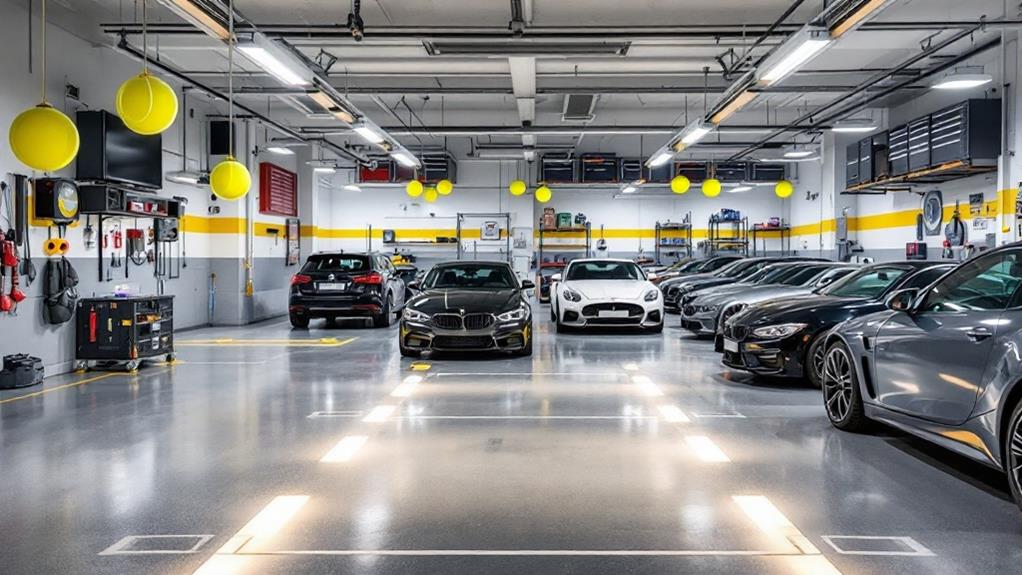
Parking precision is indispensable when fitting multiple vehicles into a single garage. To park one or two cars efficiently, you'll need some extra help from simple, low-cost parking aids. These DIY solutions can provide crucial visual references to maximize your limited space.
Start by hanging a tennis ball or swimming noodle from the ceiling as a guide. Position it so that when your car's windshield touches the ball, you've parked at the ideal spot. For added precision, align your driver's side wiper tip with the hanging ball. To secure your second vehicle is snug against the wall, place a 2x4 on the floor as a marker.
Protect your cars from dings and scratches by lining the garage walls with moving boxes. This buffer zone can prevent damage in tight quarters. While these aids may have limited effectiveness in extremely narrow garages, they're still useful for providing visual cues.
Organize Seasonal Gear Efficiently
Where do you store your seasonal gear when it's not in use? In small 2-car garages, efficient organization is vital to maintain space for vehicle parking. To maximize your garage's potential, focus on wall-mounted storage solutions that keep the floor clear for cars.
Utilize slatwall storage systems to create versatile, organized spaces for your seasonal items. These adaptable systems allow you to rearrange hooks, shelves, and baskets as your storage needs change throughout the year. Install wall-mounted racks for bulky items like kayaks, bikes, or snowboards, keeping them off the floor and out of your parking area.
Prioritize your vehicles by arranging seasonal gear on walls and in overhead storage. Keep frequently used items easily accessible, while storing less-used equipment in higher spaces. As seasons change, adapt your storage setup to maintain an organized garage focused on car parking.
Maximize Floor Space
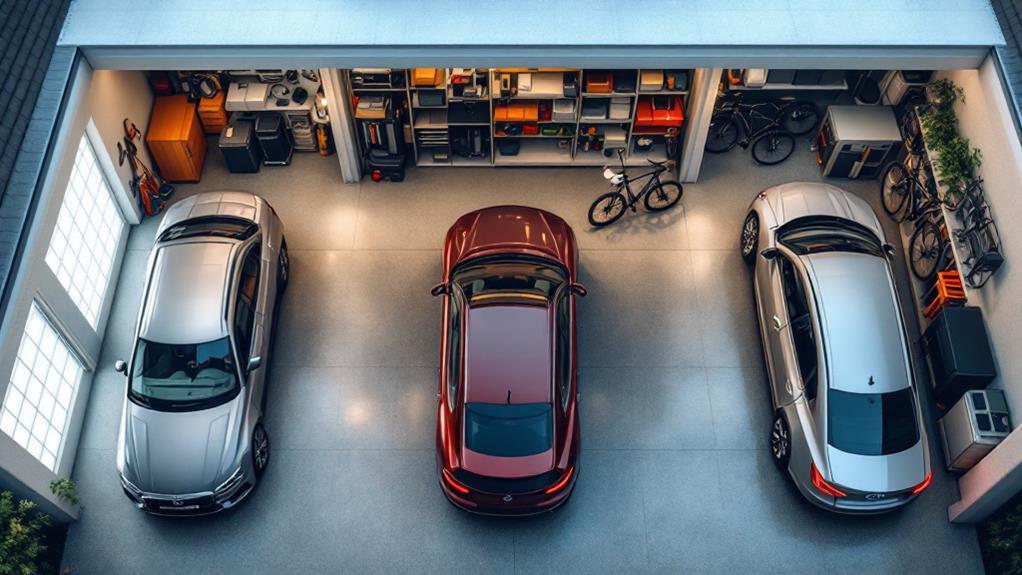
To maximize floor space in your garage, focus on up-and-out storage solutions. Leverage vertical storage options like overhead racks, wall-mounted shelving, and cabinets to free up substantial floor area for parking. This approach keeps your garage floor clear while still providing ample storage for tools, equipment, and household items.
Implement a strategic layout to optimize traffic flow and create more space around your vehicles. Consider a garage remodel that incorporates modular storage systems, allowing for customizable organization that adapts to your changing needs. You might even convert a portion of your garage into a dedicated workspace or storage area, keeping the main floor open for parking.
If you're aiming for a wide garage feel, evaluate the possibility of expanding your garage's footprint. This can accommodate larger vehicles or provide additional storage capacity. However, if expansion isn't feasible, focus on maximizing your existing space. Use efficient organization systems to guarantee every inch of your garage is leveraged effectively. By thinking vertically and strategically, you'll create a more functional space that can comfortably house multiple vehicles while maintaining easy access to your belongings.
Enhance Lighting and Visibility
With your garage's layout optimized, it's time to shed some light on the situation—literally. Enhancing lighting and visibility in your multi-car garage is essential for safety and functionality. Start by installing bright, energy-efficient LED lighting throughout the space. This will improve overall visibility, making it easier to maneuver between vehicles on both the right side and left side of your garage.
Consider adding motion-activated lighting that automatically illuminates when you enter, ensuring you're never left in the dark. To further amplify brightness, apply a reflective garage floor coating. This will enhance illumination and create a more spacious feel. Don't forget to provide adequate lighting for all work and parking areas within the garage.
To improve sightlines, strategically place mirrors to eliminate blind spots. This is especially helpful when maneuvering vehicles near the garage door or in tight spaces. If you're working with a garage builder, discuss incorporating these lighting and visibility features into the design. By implementing these enhancements, you'll create a safer, more user-friendly environment for parking multiple cars and performing various tasks in your home garage.
Consider Garage Door Configurations

Garage door configurations play an integral role in successfully parking multiple cars. If you're dealing with a single-door setup in a two-car width garage, common in homes built between 1900 and 1980, you'll need to be strategic. These garages often don't match their "two-car" description, making it challenging to maneuver and park two vehicles.
When considering garages parking multiple cars, assess whether your space is intended for storage or workspace rather than accommodating another vehicle. Some homes feature tandem garages, where one car is parked in front of the other. This configuration can work well if you don't need frequent access to both vehicles.
For small garages or those with older dimensions, you might struggle to fit modern, larger cars. In these cases, consider upgrading your garage door to cover the full width, allowing easier access for two vehicles. Alternatively, installing separate doors for each side can provide more flexibility.
Remember that the door configuration affects not only how you park but also how you use the space. By carefully considering your garage's layout and your parking needs, you can maximize its potential for multiple cars.
Plan for Future Vehicle Needs
Foresight is key when planning your garage's capacity for multiple cars. When you're designing a new home or considering garage modifications, take time to evaluate your long-term vehicle needs. Think about potential changes in your family size, lifestyle, or desire for additional vehicles. It's important to assess whether your current or planned garage can accommodate these future requirements.
As you talk about your garage plans with household members, discuss their projected vehicle ownership intentions. This conversation will help make sure that your garage meets both current and anticipated parking needs. Remember that car sizes have generally increased over time, so factor in the possibility of larger or wider vehicles in the future. You don't want to end up playing a frustrating game of automotive tennis ball, trying to squeeze oversized cars into a too-small space.
Plan for flexibility in your garage design to easily adapt to changes in vehicle ownership or sizes. Consider leaving extra room or incorporating adaptable storage solutions. By anticipating future needs, you'll create a garage that serves you well for years to come, avoiding the need for costly expansions or renovations down the road.
